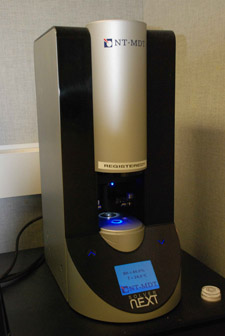Equipment
AFM Microscope

Model:
NTMDT AFM Microscope
Capabilities:
Gather sample topographical variations with accuracy on the order of fractions of a nanometer using several different imaging modes (semi-contact, contact, tapping, etc...)
Cost:
Calendar for Reservations:
Specifications:
Sample
Size: up to 20 mm in diameter, up to 10 mm in height
Sample weight: up to 40 g
Temperature control: from RT up to 150o C
Scanning system
Type of scanning: by sample
Scanning area: 100x100x10 um (with feedback sensors)
3x3x2 um in the high resolution mode
Nonlinearity, XY: 0.1 % (with feedback sensors)
Resolution
Noise XY: less than 0.3 nm (with feedback sensors)
Noise level Z (RMS in the band of 10 -1000 Hz): 0.03 nm (typically) with feedback sensors
0.02 nm in the high resolution mode
System of sample positioning
Method: automated, video monitored
Range, XY: 5x5 mm
Min. step: 0.3 um
Video monitoring system
Resolution: 2 um
Focus: motorized
Zoom: continuous
The AFM consists of a cantilever with a sharp tip (probe) at its end that is used to scan the specimen surface. When the tip is brought into proximity of a sample surface, forces between the tip and the sample lead to a deflection of the cantilever according to Hooke's law. Depending on the situation, forces that are measured in AFM include mechanical contact force, van der Waals forces, capillary forces, chemical bonding, electrostatic forces, magnetic forces, Casimir forces, solvation forces, etc. The deflection is measured using a laser spot reflected from the top surface of the cantilever into an array of photodiodes which is used to output a topographical map of the scanned area for user analyses.
